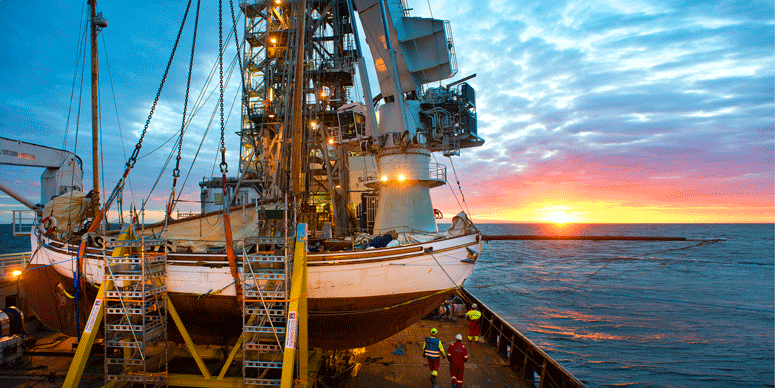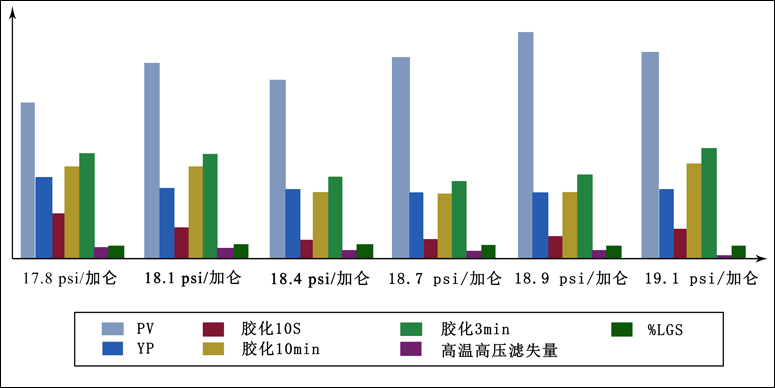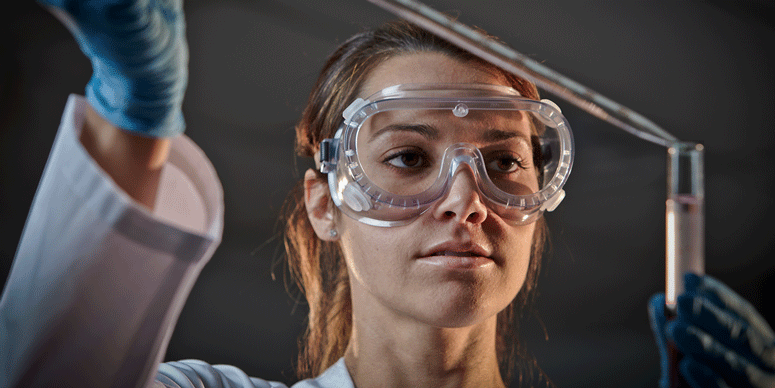Despite hostile wellbore conditions, an operations team overcame challenges of drilling-fluid design and management to drill the first ultra high pressure/ high-temperature (HP/HT), deep-gas well offshore Malay Peninsula. With a bottomhole temperature (BHT) of 488°F, the well reached the highest temperature ever recorded in Southeast Asia. Thorough planning and advanced drilling-fluid technology resulted in drilling fluids with extreme temperature stability. Designing, planning, and deploying a thermally stable drilling fluid for this high-temperature environment helped reduce the time required for circulating or conditioning, thus reducing rig time and mud treatment cost.
Introduction
Because of extreme wellbore conditions, HP/HT drilling and exploration involve engineering expertise, competent well design, and enabling HP/HT technologies. Among enabling technologies, thermally stable drilling-fluid systems remain one of the key components for successful HP/HT drilling operations. As a result of fluid-engineering design and extensive testing, a suitable ultra-HP/HT drilling fluid was formulated with a maximum mud density of 18 lbm/gal and thermal stability of 455°F. The successful drilling of this first ultra-HP/HT gas well set a new benchmark for the operator in designing, planning, and managing drilling fluid. The effort underlines the importance of high-temperature drilling-fluid technology, which led to reduced cost and time in the operation.
Well Background and Operational Goal. The well was the operator’s first ultra-HP/HT, deep-gas exploration well in the south Malay basin. It was a straighthole, vertical well with a water depth of 251 ft. The well was drilled to a total depth of 14,380 ft, where it reached a pressure of 14,282 psi and maximum bottomhole static temperature (BHST) of 488°F. The operational goal of the well was the evaluation of the hydrocarbon potential in the Group M sandstone, where the reservoir pressure and temperature are greater than 14,000 psi and 450°F, respectively.
Ultra-HP/HT Drilling-Fluid Design. The key objectives for drilling-fluid performance include _ Zero nonproductive time (NPT) associated with drilling fluids _ Thermally stable, high-density fluid with desirable low rheological properties with no barite sag under static or circulating conditions _ No excessive equivalent circulating density (ECD) associated with drilling fluid at bottomhole circulating temperature _ Controlled HP/HT fluid loss under.wellbore conditions
Well Performance: Drilling- Fluid Key Achievements
Superior Ultra-HP/HT Drilling Fluid Beyond 450°F. Using laboratory-test results, ultra-HP/HT drilling fluids were formulated up to 18-lbm/gal density and tested for stability at 455°F. Test results showed no barite settling during the 96-hour static aging test, and the fluid rheological properties were within the required specifications. During drilling operation, the actual pore pressure was higher than predicted, requiring an increase in mud density up to 19.1 lbm/gal (instead of 18 lbm/gal). The 17.8-lbm/gal synthetic-based mud (SBM) was used to drill ahead at the start of the ultra high temperature zone.
Fig. 1 shows the field mud properties for drilling the ultra-HP/HT zone. The operator drilled with the 17.8-lbm/gal SBM and gradually weighted up to the maximum mud density of 19.1 lbm/gal at total depth (TD). A weight-up pilot test of the fluid was conducted for every density increase. After the mud engineer identified an appropriate treatment with the pilot test, fresh premixed mud was prepared in a slug pit and slowly transferred to the active system while drilling to maintain low fluid rheological properties and control mud weight. Dilution with base oil was used as necessary for maintaining the oil/water ratio of the drilling fluid. The base formulation handled the higher barite loading with minimal formulation adjustment, suggesting a robust drillingfluid formulation.
Because of possible barite settling when the well was static during wireline operations, the operator requested a mud-weight check every five pipe stands while running into the hole. There was no difference in the in and out mud densities. The fluid showed no variation in mud density within a particular mud weight. There was no evidence of barite settling, even though, at TD, the 19.1-lbm/gal mud was static for 5 days at 488°F BHST during the logging operation.
Fig. 1—Comparison of HP/HT fluid properties in the interval (surfacemud from an active well).
A comparison was made of the 18.1-lbm/gal field mud properties measured on the surface (150°F and ambient pressure). The field mud was collected while the well was static during wireline?logging.
The projected BHST for this interval was 340–455°F. According to the postwell review, the wireline was run in the hole without any problems. After wireline logging was completed, the operator circulated full bottoms up and the mud properties remained good. The results show that the fluid maintained consistent rheological properties during 4?days at a static condition. Temperature and pressure strongly affect the rheological properties of the mud. The mud properties measured on the surface do not always correspond to those downhole, where fluid is exposed to elevated wellbore temperatures and pressures. The operator was concerned about possible barite sag because of the low 6-rev/min surface reading. Therefore, the 18.1-lbm/gal field mud sample was sent back to the laboratory for an HP/HT rheology evaluation and sag test.
Laboratory testing showed that the sag index after 2 and 4 days of static aging was 0.532 and 0.538, respectively. These sag-test results support the observation that there was no barite sag during the 4-day logging operation despite marginally low 6-rev/min surface readings measured at the rigsite. With this validation, the surface properties must be used only as a guideline for treatment. To determine the HP/HT rheological properties of the 18.1-lbm/gal field mud sample, the ranges of temperatures (84–486°F) and pressures (15–14,675?psi) tested were selected to simulate bottomhole conditions.
The HP/HT behavior of the field mud was important not only for identifying and recommending the mud treatment but also for enabling operators to drill ahead. The HP/HT viscometer results confirmed that the field mud was thermally stable, with desirable plastic-viscosity (PV), yield-point (YP), and yield-strength properties during wellbore conditions. Particle-size analysis indicated no major colloidalsolids buildup in the field samples (during the drilling operation). Daily mud reports indicated less than 5% low-gravity solids (LGS) in the system.
For higher-density field muds (18.7, 18.9, and 19.1 lbm/gal), fluid properties exhibited a trend similar to that of the 18.1-lbm/gal field sample, showing stability with robust rheological properties on surface measurements (high PV and YP but low 6-rev/min reading) and meeting specifications during elevated bottomhole temperature and pressure.
Zero NPT Associated With Drilling Mud. Rig cost is the major operational expense for an offshore HP/HT operation. The offshore-rig day rate can range up to USD 1 million, depending on the rig type, capability, and drilling location. Because the reduction of fluid- related NPT was a key objective for this drilling operation, a substantial effort was put into designing thermally stable, high-density drilling-fluid formulations. The field data verified the benefit of advanced drilling-fluid design. The stability of the drilling fluid at extreme temperatures simplified the fluid- maintenance effort required to ensure optimal rheological properties and LGS content. These factors contributed to better management of equivalent static density and ECD, which reduced the likelihood of lost circulation or hydraulic fracturing of the formation. In addition, the drilling fluid had fairly steady rheological properties and exhibited no barite settling during the extended logging operation at the BHST of 488°F. Less circulation time was necessary for fluid conditioning. Furthermore, the fluid design helped minimize treatment cost.
Cost Savings. This exploratory gas well was the first well drilled to an extreme bottomhole temperature of 488°F in Southeast Asia. The cost savings were estimated through the operator’s observations and compared with other HP/HT operations in Malaysia. A final review of the mud cost for the ultra-HP/HT section indicated that the actual hightemperature- drilling-fluid cost was approximately 19% higher than what was proposed. The increased mud cost was a result of higher than projected mud density and extra dilution required for maintaining desirable low fluid rheological properties. The outstanding ultra- HP/HT drilling-fluid performance in the field underscored the importance of good collaboration between the operator and service companies in planning, design, and management of the drilling fluid for extreme temperature and pressure. The successful drilling operation of the deepgas well set a new record for the operator in the ultra-HP/HT realm and a record for the Southeast Asia? region.

 石油圈
石油圈


